Mosques
740 mosques were destroyed by communist authorities in 1967 when state atheism was first introduced in the country. [2]
This is a list some of the main mosques in Albania. [1]
740 mosques were destroyed by communist authorities in 1967 when state atheism was first introduced in the country. [2]

Our Lady of Ljeviš is a 14th-century Serbian Orthodox church in the town of Prizren, in southern Kosovo. Since 2006, the church is part of the UNESCO World Heritage Site named Medieval Monuments in Kosovo.
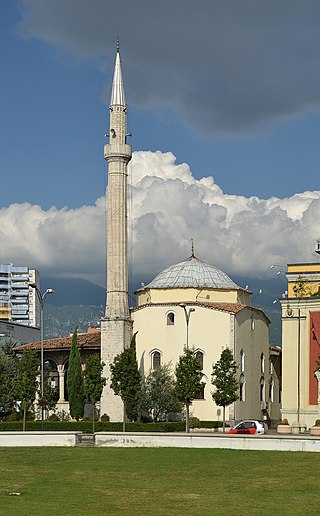
The Et'hem Bey Mosque is a mosque in Tirana, Albania. Closed under communist rule, the mosque reopened as a house of worship in 1991. Without permission from the authorities, 10,000 people attended and the police did not interfere. Frescoes outside and inside the portico depict trees, waterfalls and bridges.

Islam in Kosovo has a long-standing tradition dating back to the Ottoman conquest of the Balkans. Before the Battle of Kosovo in 1389, the entire Balkan region had been Christianized by both the Western and Eastern Roman Empire. From 1389 until 1912, Kosovo was officially governed by the Muslim Ottoman Empire and a high level of Islamization occurred among Catholic and Orthodox Albanians, mainly due to Sufi orders and socio-political opportunism. Both Christian and Muslim Albanians intermarried and some lived as "Laramans", also known as Crypto-Christians. During the time period after World War II, Kosovo was ruled by secular socialist authorities in the Socialist Federal Republic of Yugoslavia (SFRY). During that period, Kosovars became increasingly secularized. After the end of Communist period religion had a revival in Kosovo. Today, 95.6% of Kosovo's population are Muslims, most of whom are ethnic Albanians. There are also non-Albanian speaking Muslims, who define themselves as Bosniaks, Gorani and Turks.

The Lead Mosque, also known as the Buşatlı Mehmet Pasha Mosque, is a historical mosque in Shkodër, northwestern Albania.

The Sinan Pasha Mosque is an Ottoman mosque in the city of Prizren, Kosovo. It was built in 1615 by Sofi Sinan Pasha, bey of Budim. The mosque overlooks the main street of Prizren and is a dominant feature in the town's skyline.

The Bazaar Mosque, also known as Memi Bey Mosque, is a mosque located in Gjirokastër, Albania.
The Sanctuary (church-mosque) in Shkodër, Albania is a Cultural Monument of Albania.

The Bejtul-Evel Mosque commonly known as Baitul Awal Mosque is Ahmadiyya Mosque in Tirana, Central Albania, Albania.

The Tanners' Mosque is a historic mosque located near the Tanners' Bridge in Tirana, capital of Albania. Built in the neighborhood of the handicraft-trade Tanners' guild around the seventeenth century in the Ottoman Empire, it was damaged by a lightning shot but continues to function thanks to improvements made by the family Resmja which even today continues to care for.
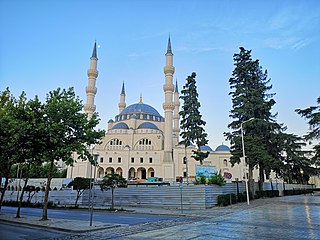
The Great Mosque of Tirana or Namazgah Mosque is a mosque which is currently being built in Tirana, Albania. When completed, it will be the largest mosque in the Balkans.

The Mosque of Mahmud Agha Kokonozi or New Bazaar Mosque is a mosque in Tirana, Albania. It is an Ottoman-era mosque built in 1750 and one of the few mosques that survived the communist dictatorship under the Hoxhaist regime.

The Grand Mosque of Durrës or New Mosque is a historic Albanian Mosque in the port-town of Durrës, Albania.

The architecture of Albania is a reflection of Albania's historical and cultural heritage. The country's architecture was influenced by its location within the Mediterranean Basin and progressed over the course of history as it was once inhabited by numerous civilisations including the Illyrians, Ancient Greeks, Romans, Byzantines, Venetians, Ottomans as well as modern Austro-Hungarians and Italians. In addition, missionaries, invaders, colonisers and traders brought cultural changes that had a large profound effect on building styles as well as techniques.
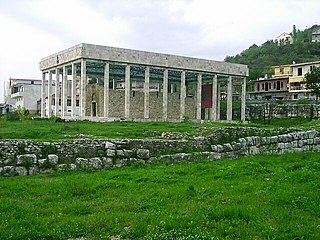
The Church of Saint Nicholas(Albanian: Kisha e Shën Nikollës/Kisha e Shna Kollit), former Selimije Mosque, or Church of Lezhë (Kisha-Xhami) is a ruined historic church where the remains of Skanderbeg are said to be preserved in Lezhë, Albania. It is now used as Skanderbeg's Mausoleum in Lezhë, Albania.
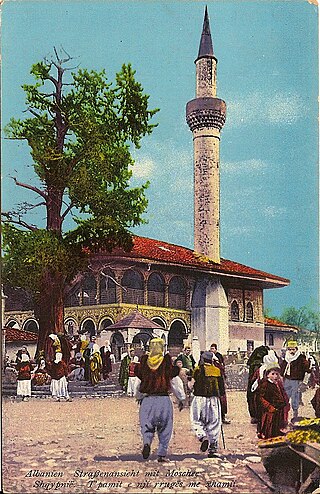
The Old Mosque or Sulejman Pasha mosque was the founding mosque of the Albanian capital Tirana. The city developed around the mosque, which was founded by the Ottoman Albanian Pasha Sulejman Bargjini along with a hammam and a bakery. In the mid of the 20th century, all of it was razed to make place for the Communist-era Unknown Soldier statue.

The architectural heritage of the Kosovo Albanians during Yugoslav rule was shown institutionalised disregard for decades prior to outright conflict at the end of the 20th century. Numerous Albanian cultural sites in Kosovo were destroyed during the period of Yugoslav rule and especially the Kosovo conflict (1998-1999) which constituted a war crime violating the Hague and Geneva Conventions. In all, 225 out of 600 mosques in Kosovo were damaged, vandalised, or destroyed alongside other Islamic architecture during the conflict. Additionally 500 Albanian owned kulla dwellings and three out of four well-preserved Ottoman period urban centres located in Kosovo cities were badly damaged resulting in great loss of traditional architecture. Kosovo's public libraries, of which 65 out of 183 were completely destroyed, amounted to a loss of 900,588 volumes, while Islamic libraries sustained damage or destruction resulting in the loss of rare books, manuscripts and other collections of literature. Archives belonging to the Islamic Community of Kosovo, records spanning 500 years, were also destroyed. During the war, Islamic architectural heritage posed for Yugoslav Serb paramilitary and military forces as Albanian patrimony with destruction of non-Serbian architectural heritage being a methodical and planned component of ethnic cleansing in Kosovo.

The Albanian Mosque, also known as the Albanian Australian Islamic Society Mosque and Carlton Mosque, is a mosque located in Carlton North, a suburb of inner Melbourne, Victoria, Australia. The building contains a minaret, and community facilities. Associated with the Albanian Australian community, the mosque is owned by and the centre of the Albanian Australian Islamic Society (AAIS) of Victoria, whose membership numbers some 1000 people. Constructed began in the mid 1960s and was completed by 1969. The mosque is the oldest in Melbourne and listed on the Victorian Heritage Register.
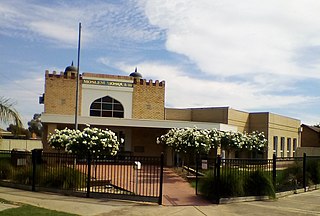
The Albanian Mosque, also known as the Shepparton Mosque, is a rural Sunni mosque located in a residential area of Shepparton, a regional city in Victoria, Australia. Associated with the Albanian Australian community, the mosque is owned by and the centre of the Shepparton Albanian Moslem Society (SAMS). Built in the late 1950s, the mosque is the first and oldest in Victoria.
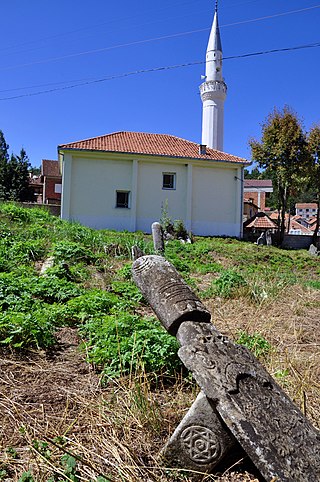
The Al–Aga Mosque, also known as the Mosque of Haxhi Hussein and Ahmet Aga Mosque is the oldest mosque in Kosovo as well as in the entire Balkan region. It is located near Dragash and was built in 1289.